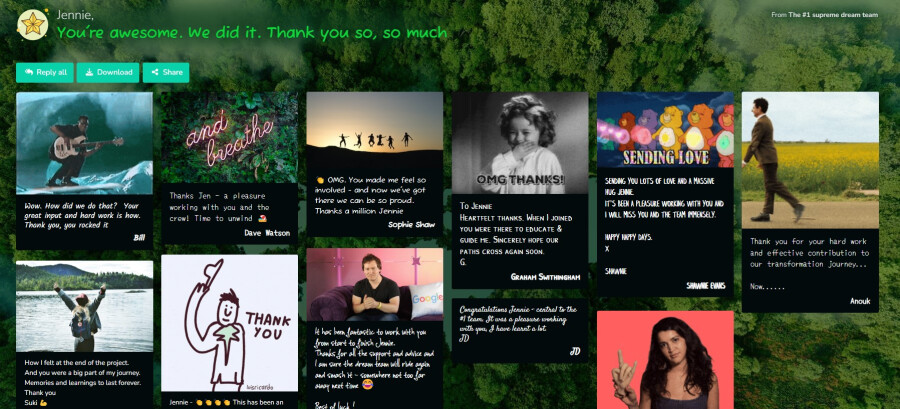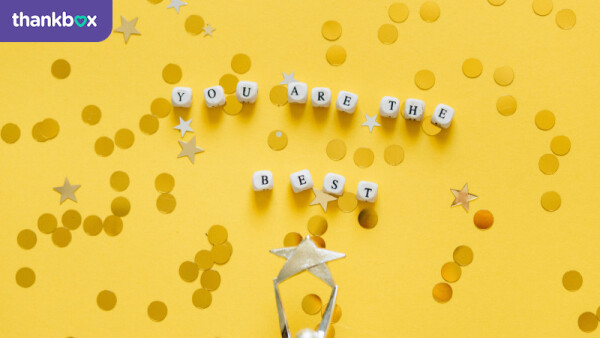Here’s Our Complete Guide to Employee Appreciation in 2024


Everyone wants to feel appreciated. It’s a basic human desire, and any manager or company leader would probably agree that it's important in the workplace.
So, why have 65% of employees not received any form of appreciation over the last year?
We’re not quite sure. However, one thing we know at Thankbox is that employees (no matter their role) love getting thank yous from the team occasionally.
This article will teach you how to implement effective employee appreciation, show you the main benefits of implementing an effective appreciation strategy, and provide some ideas for your team.
Let’s begin.
What is employee appreciation?
Employee appreciation is when you recognise employees for their contributions and express gratitude. It's about acknowledging their efforts, celebrating their achievements, and valuing their role within the company.
Employee appreciation can take many forms, including:
Verbal or written praise
Awards
Bonuses
Promotions
Special events
Gestures of thanks
The goal is to boost morale, improve job satisfaction, and foster a positive work environment. Employee appreciation can increase productivity, retention, and overall organisational success when done effectively.
Benefits of showing appreciation to your employees
Increased employee loyalty
An Australian study found that 63% of employees would prefer to work for a company where they’re regularly thanked for their hard work, rather than a company with a 10% higher salary but no praise.
Which do you think costs you more? Saying thanks can be free, although you should do more than that to make the thanks more meaningful.
Strengthening employee loyalty through appreciation is a powerful strategy for organisations. Recognising employees' efforts and contributions fosters a sense of belonging and commitment to the company. When employees feel valued, they're more likely to develop a strong allegiance to their workplace.
Plus, high turnover rates can be costly, showing your gratitude makes retention a lot simpler.
More engaged employees
When employees feel appreciated, they're more likely to be deeply involved.
After being thanked, you’ll find that employees are motivated to work harder.
The lesson should be that happy employees are more willing to go the extra mile. You won’t need to spend as much time motivating them either. And a rising tide lifts all ships. As you show appreciation to various employees in your organisation, both around the office and in private, you’ll see the cheer slowly spread between colleagues.
Boosted productivity
According to a behavioural study, high-performing teams receive an average of 6X more praise and gratitude than lower-performing ones.
It’s easy to see the impact on productivity. Employees who feel recognised are more motivated to maintain or improve their performance. They often take greater pride in their work, leading to higher quality outcomes and efficiency.
As a result, productivity increases not just because employees work harder, but because they work smarter, with a greater sense of purpose and engagement.
BUSINESS_CTA
Improved job satisfaction and reputation
Appreciation makes employees feel valued and satisfied with their jobs. This satisfaction comes from knowing that your organisation values their contributions. Satisfied employees are more positive about their work environment, and have fewer job-related complaints.
Increased job satisfaction can also help your company develop a strong reputation. It’s a little hack to help you attract talent. It won’t be long before the news about your incredible company culture spreads to everyone in your area or industry.
Enhanced team morale
Sometimes, you want to have employee appreciation days all at once. Recognising individuals' efforts and achievements can have a ripple effect, boosting the entire team's morale.
High morale leads to a more positive work environment, where employees feel motivated and supported by their peers and management. Teams with high morale are often more cohesive, collaborative, and effective in achieving their objectives.
How to do employee appreciation (5 steps)
1. Set clear objectives for the appreciation program
The foundation of any successful employee appreciation program is its objectives. This step requires defining what the program aims to achieve within the organisation.
You should start by identifying behaviours and achievements that you want to reward. For instance, you might want to reward employees for finishing work early or for helping you bring in a new client. It all depends on your specific workplace activities.
2. Decide on the forms of appreciation and rewards
After setting the objectives, the next step is to select the forms of appreciation and rewards offered.
This decision should consider the organisation's culture, workforce diversity, and the program's objectives. Forms of appreciation can vary widely, from verbal praise and thank-you notes to tangible rewards like bonuses, gifts, extra time off, or professional development opportunities.
Ask your employees how they would like to be valued. They know better than anyone which rewards would help them feel appreciated. You should add their feedback to the mix of ways you show appreciation.
If you want to thank your employees properly, send professional-looking thank-you notes using Thankbox. It only takes a few clicks to put together a wonderful card. And if you’re wondering what to write, just look at our list of potential appreciation messages.
Remember—it's important to offer a variety of rewards to cater to different preferences and to ensure the appreciation is perceived as genuine and meaningful.
3. Communicate the appreciation program to all employees
Let your employees know that you’re introducing a new appreciation program. For example, if you have a task you can all work towards as a team, let them know there will be a big appreciation dinner at the end.
Transparency is key to ensuring that employees understand how they can be recognised and how they can participate in recognising others. Make sure that the message reaches everyone so that you all know you’re working towards a common goal.
BUSINESS_CTA
4. Implement the program and start recognising employees
With the program communicated, the next step is to implement it. This involves starting the recognition and reward processes as outlined in the program. Recognition should be timely, relevant, and aligned with the established criteria to ensure effectiveness.
Managers and leaders play a crucial role in this step, as they're often in the best position to observe and acknowledge employees' contributions. You should train any managers and supervisors on how to recognise employees effectively.
Of course, you’ll also need to coordinate your employee appreciation events when they come up. Make sure that you have a plan for hosting these events as well.
5. Evaluate regularly
Keep track of the program’s performance. Collect feedback from your staff regarding your employee appreciation events. Find out what they liked and what they didn’t. It’s about showing your employees that you care about the program, and that means you care about them, too.
14 employee appreciation ideas your team will love
Employee appreciation is about more than just recognising birthdays. In fact, some of the most impactful appreciation days can be those your employees never expected!
Here are some ideas to help you get started while you plan your employee appreciation strategy:
Send a personalised thank you from leadership to each employee
A personalised thank you note from leadership to each employee is a direct and heartfelt way to acknowledge their individual contributions and efforts. It signals that the leadership not only recognises but also values each employee's unique role in the organisation's success.
Personal recognition from leadership can significantly boost an employee's morale and sense of belonging. It bridges the gap between management and employees, fostering a culture of openness and mutual respect.
Such gestures make employees feel seen and appreciated on a personal level, which can enhance their emotional connection to the organisation.
Putting it into action:
When you send a personalised card, make sure to use Thankbox. It’s much quicker than passing a note around the office for others to sign.

Plus, you can include:
Video messages
Gifs and stickers
Photos from past company events
Encouraging words and praise for a job well done
While you put your Thankbox card together, highlight each employee's achievements or qualities, making the appreciation feel genuine and tailored. Incorporating details about the employee's contributions or mentioning particular projects they've worked on can add a layer of personalisation that makes the card even more impactful.
Want to make your Thankbox e-card even more impactful?
We also offer digital gift cards and flower delivery to accompany your message. Whether for a special occasion or just a random act of kindness, these small gestures can go a long way toward making someone feel appreciated and valued.
Employee appreciation lunch or dinner parties
Hosting an appreciation lunch or dinner party is a way to celebrate employees collectively in a relaxed and social setting. It’s team building and employee appreciation all rolled into one.
These events provide a break from the routine work environment and allow team members to bond and enjoy each other's company, all while being recognised for their hard work and dedication.
This can show your team that you’re more than the sum of your parts. Plus, it demonstrates your organisation's willingness to invest in its employees' happiness and well-being beyond the workplace.
Putting it into action:
To plan an appreciation lunch or dinner you should choose a venue that matches the company's size and budget—whether it's a sophisticated dinner at a restaurant, a casual lunch at the office, or even a catered event in a unique location.
It really depends on the occasion.
Invitations should reflect the event's significance as a token of appreciation, and leadership should try to express their gratitude during the event, possibly with short speeches or informal toasts.
Here’s a bonus tip to make the event more memorable—incorporate themes, awards, or entertainment that align with the company culture. Ensuring that the event accommodates all employees, including those with dietary restrictions or other needs, is also crucial for making everyone feel included and appreciated.
Celebrate milestones together
Celebrating milestones together involves acknowledging significant organisational achievements or anniversaries, such as project completions, work anniversaries, or achieving specific company goals. It could also be as simple as celebrating someone’s birthday, or if you have a large office, celebrating birthdays once a month.
Marking milestones reinforces a sense of accomplishment and unity among employees, showing them that their efforts contribute to the larger success of the organisation. It's an opportunity to reflect on past achievements and motivate the team for future challenges.
Putting it into action:
Your events could take just about any form, like:
Team outings (mini golf, bowling, escape rooms, etc.)
Office parties or happy hours
Lunch or dinner celebrations
Company-wide picnics or barbeques
Highlighting specific contributions from team members during these events and possibly incorporating awards or recognition for outstanding work can add a personal touch. For work anniversaries, personalised gifts or messages that reflect the individual's journey within the company can make the occasion even more special.
Of course, as more and more teams go remote, it can be harder to give people the well wishes they deserve. That’s where Thankbox comes in with our online group cards.
Thankbox removes the need to send the card around the office to be signed. Instead, you just need to pass it around the virtual office. Employees can offer their unique birthday wishes, even including photos or GIFs if they’re inclined.
Once the recipient gets the card, they’ll have something they can remember and cherish—much more impactful than saying “Happy birthday!” over a Zoom call.
Group volunteer day for an employee-driven cause
Here’s a great way to give back to the community and make your employees feel valued. Set aside time for everyone to step away from their regular work duties to volunteer for a cause. Allowing employees to choose the cause ensures that the activity aligns with their values and interests, enhancing their commitment and participation.
This activity fosters teamwork and promotes a sense of purpose beyond the workplace.

Volunteering as a group strengthens team bonds through shared experiences rooted in giving back to the community. It demonstrates the organisation's commitment to social responsibility and to supporting causes important to its employees, boosting morale and enhancing the company's internal and external image.
Volunteering can give employees a refreshing break from their routine, offering new perspectives and a sense of fulfilment from helping others.
Putting it into action:
Start by surveying employees to identify causes they are passionate about. Once a cause is selected, organise a day or half-day where employees can volunteer, ensuring the project is manageable and meaningful.
Coordinate with a local nonprofit or community organisation and tell your employees you value these efforts. Then, you can document the day with photos and share the experience in company communications to celebrate the team's work and inspire further volunteerism. You could even show it off a bit on social media.
10 More Interesting Employee Appreciation Ideas
"Behind-the-Scenes" tours of interesting local businesses
"Mystery Box" challenge with creative tasks
Custom caricatures for team members
"Escape the Office" - Escape room experience
Professional development day chosen by the employee
"Pet Day" - Bringing pets to work or a virtual show and tell
Custom playlist creation where each employee adds their favourite song
"Secret Santa" any time of the year
Outdoor movie night for employees and their families
DIY team-building workshop (pottery, painting, cooking)
BUSINESS_CTA
Wrapping up
There are no more excuses. Many companies neglect to show their employees that they care. Now, you have all the tools and ideas you need to show your employees that they are valued team members.
Remember, you don’t need to make employee appreciation a grandiose event every time. The key to employee appreciation is consistent messaging, and what better way to show appreciation than with Thankbox? It’s a fun way to gather your whole team together and single one of them out for their important contributions.
Images: Cover | People volunteering





